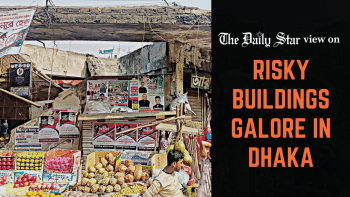What if an earthquake of 6.9 magnitude hits Dhaka?

Shortly after noon on Sunday, Tangail and its nearby areas were struck by an earthquake of 4.4 magnitude. While this was a minor quake and resulted in no casualties, earthquakes have been observed at a higher rate recently not only in Bangladesh, but worldwide. On the afternoon of September 9, for instance, a 4.4-magnitude quake shook Sylhet. Another 3.9-magnitude earthquake, the epicentre of which was in Bhulta of Narayanganj, hit Dhaka on April 25.
Against the background of such frequent quakes, we must ask: is Dhaka adequately prepared to face a 6-7 magnitude earthquake? Are we planning our cities, buildings, and infrastructure in a way that would make the capital safe for our lives and properties, given its vulnerability to earthquakes? Are our development authorities diligently enforcing planning laws and building codes?
Unlike cyclones, earthquakes cannot be accurately predicted. Hence, requisite preparations are needed from urban development authorities. Unplanned urbanisation, unsafe building development, coupled with the expansion of urban areas in low-lying or marshy areas have greatly aggravated the capital's earthquake vulnerability, which has a population of nearly 20 million people. We must remember that a large portion of this population dwells in poorly built structures, and even in semiformal and informal housing in unsafe and precarious conditions.
Better preparation in terms of maintaining building codes and planning rules could save lives to a great extent, which has been seen in the experiences of recent earthquakes in Chile, Haiti, and Turkiye. In 2010, Chile experienced a quake of 8.8 magnitude, which killed 700 people, while the Haiti 7.0-magnitude earthquake killed around 220,000 people in the same year. Chile established strict building codes in 1985 following a 7.8-magnitude earthquake; and Haiti had no national building code and no means of checking building safety.
Unplanned urbanisation, unsafe building development, coupled with the expansion of urban areas in low-lying or marshy areas have greatly aggravated the capital's earthquake vulnerability, which has a population of nearly 20 million people. We must remember that a large portion of this population dwells in poorly built structures, and even in semiformal and informal housing in unsafe and precarious conditions.
The 7.8-magnitude earthquake that hit Turkiye on February 6 resulted in a death toll of over 50,000, while more than 160,000 buildings collapsed or were severely damaged. This gave rise to questions about whether the natural disaster's impact was made worse by a lack of building and planning compliances.
Reports on the Turkiye-Syria earthquake revealed that unplanned urbanisation, material weaknesses, insufficient inspection processes, and illegal constructions were the main factors behind the extensive destruction. These factors are also prevalent in the urban development and building construction practices for urban areas in Bangladesh.
At least 65 percent of Dhaka and its surroundings are at high risk of earthquakes, as the buildings have been constructed on landfills due to unrestricted urbanisation, and have not taken into consideration the nature of the soil or earthquake vulnerabilities of the area in general. Rapid construction of housing and high-rise infrastructure on weak land, without carrying out proper study on geological features, have alarmingly increased the risk of earthquakes and other urban disasters in Dhaka.
The expansion of Dhaka city to the east and southwest has therefore made it more vulnerable to liquefaction during earthquakes, since buildings in these areas are erected by filling up water reservoirs and wetlands, in violation of building codes.
In order to ensure building safety, we have the Bangladesh National Building Code (BNBC), updated in 2020, and the Dhaka Building Construction Rules, 2008. There are also physical plans like the Detailed Area Plan that provide detailed guidelines for urban development in different land-use zones in Dhaka. Despite this, a large number of buildings in the capital have not been designed properly or have been constructed violating land use guidelines, which may turn out to be dangerous in case of a moderate to strong earthquake.
According to a survey by the Rajdhani Unnayan Kartripakkha (Rajuk), nearly 865,000 buildings would collapse in Dhaka city if an earthquake of 6.9 magnitude strikes at Madhupur fault in Tangail. Additionally, 210,000 people would die and another 229,000 would sustain injuries if the quake strikes during the day. As per a survey conducted by Rajuk in 2018, an alarming 67 percent of buildings were found violating building codes, out of 1.95 lakh buildings surveyed.
We may recall the March 13 declaration by Rajuk relating to the evacuation and demolition of 42 dangerous buildings identified by its Urban Resilience Project. It also listed around 342 buildings, owned by various government organisations, as being risky for living. But no significant progress has been made since Rajuk provided the notice to the owners of the buildings to vacate the structures. This is proof of the utter disregard and apathy towards building safety and earthquake preparedness from different authorities and building owners.
A devastating earthquake could hit anytime and would be quite catastrophic for us. Yet, we are wildly ill-prepared to face something like this. A specific authority should be formulated on an urgent basis to enforce the Bangladesh National Building Code in order to increase building safety. Urban development in low-lying areas should be strictly prohibited, even for government projects. The government should no longer allow the violation of planning guidelines and building codes, and must take appropriate measures against violators. Planning and investment is required so that our utility services and facilities do not collapse in the case of a major earthquake.
The corruption in the supervision and monitoring system of Rajuk and related bodies must be checked. We welcome recent directives from Rajuk to mandate the submission of architectural, structural, fire safety, electrical, and plumbing plans before building construction. However, making planning permits – which still does not exist in Bangladesh – mandatory is required as well to increase building safety and urban resilience. Third-party monitoring of building construction, as planned by Rajuk, could help push this forward. However, there is no scope for laxity by development authorities and urban bodies in monitoring the overall urban development process. We cannot prevent earthquakes; but we should be properly prepared against them to save invaluable lives.
Dr Adil Mohammed Khan is executive director at Institute for Planning and Development (IPD) and professor at the Department of Urban and Regional Planning of Jahangirnagar University. Reach him at [email protected]

 For all latest news, follow The Daily Star's Google News channel.
For all latest news, follow The Daily Star's Google News channel. 











Comments